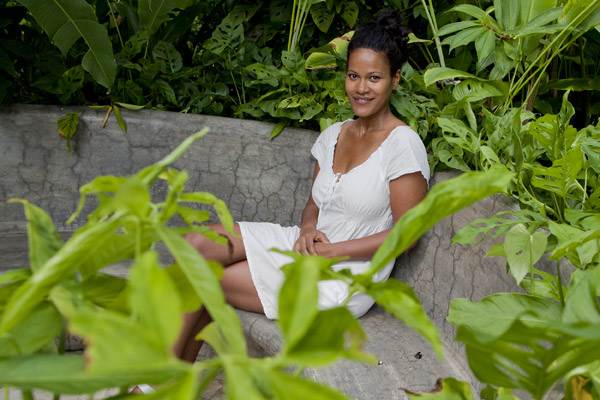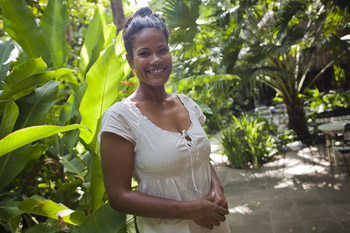What director and producer Ayana de Vos loves most about making films is that you can touch people. “If a film is nicely done, it is powerful and hopefully reaches the people,” she said.
She hopes to reach people around the world with a documentary about recycling in tropical countries that she is filming in Nosara. The 90-minute feature-length film will document the creation of a new recycling center at the Nosara dump, a project being organized by Ayana’s husband, Tobias Holler, who is an assistant professor of architecture at New York Institute of Technology. |
|
 |
During the months of July and August, 35 of his architecture students will be volunteering their time and energy to build the new recycling center, and Ayana will be capturing the activity on film.
Ayana knew she wanted to make a film about the recycling center as soon as the project was suggested. She is drawn to making documentaries about positive community initiatives in different places around the world so that other people learn about the projects and might be inspired to help with the project or to develop a similar project in their own community.“All together we can make a difference,” is the message that Ayana hopes will reach people around the world.
For example, Ayana filmed a documentary about the last orangutans living in the wild in the vanishing rainforests of Borneo, Indonesia. The film was broadcast all over Europe, generating more support and more funding for the project to protect the orangutans. That’s the kind of change that makes Ayana feel successful as a filmmaker.
| Although she has shot numerous documentaries during her 10-year career, the documentary she is filming in Nosara will be her first independent film. She explained that she didn’t want TV production involved in the film because documentaries made for specific programs are generally made in a short amount of time and she always had more ideas for the documentaries that the limited timeframe wouldn’t allow her to explore. For her film about Nosara, however, she wanted the luxury of time to give the film enough love and shoot it until she thinks it’s done. |
|
 |
Ayana said one of the most important things about the film will be showing what happens when people try to make a change with whatever they have to offer. The people here in Nosara will be central to the film. Through them, Ayana hopes to get to know what local people really think of the project and tell from the bottom of their hearts why this recycling project is important. “This place is all about nature,” Ayana noted. During her interviews with people in the community she has learned that people feel the most important aspect is education. Currently, every bag of garbage has to be opened and the recyclable material has to be sorted out by hand.
Ayana first visited Nosara two years ago and fell in love with the area. “There’s no way you can’t fall in love with it,” she said. “I love animals although I’m really scared of the snakes. I’ve never seen so many wild animals in my life.” Ayana joked that she’s from Jamaica, where the most dangerous creature is a caterpillar.
Ever since she was a little girl, Ayana de Vos always wanted to be a filmmaker. In Germany’s competitive arena, Ayana made that dream come true through perseverance and, according to her, a lot of luck. When she was only 22, she got an internship at one of Germany’s major film companies, SpiegelTV. After three or four months, she was encouraged to go somewhere else, being told that she was too young to get hired on by the company. However, she stuck it out, bartending on the side to survive economically and proving to the company how much she wanted it. After about 9 months she got hired on and was sent to the journalism academy. Ayana said that the educational program in Germany is very competitive; 450 people wanted in, but the academy could only take 12. “I got very lucky again,” she recalled.
Ten years into her career, Ayana is exploring new horizons, making this independent film in Nosara and also preparing her first screenplay about a black German getting married, dealing with the theme of racism in the form of a comedy, which she says is “a nicer way of telling the story.”
Although Ayana is interested in narrative films, she feels she isn’t a good writer. “I think I can express myself the best through music and pictures. Film has so many tools you can use.” Those tools include picture, voice, atmospheric sound and music as well as narrative. She plans to incorporate narrative into the documentary she is filming in Nosara, using actors to mix a narrative story into the documentary to create a different kind of film.
She hopes to finish the film by August 2013 and plans to show it at several film festivals as well as presenting it to companies in Germany and possibly PBS in the United States. Through this film, she hopes to showcase the collaboration between Nosara residents and foreigners to bring about a positive change in the community.
| 
